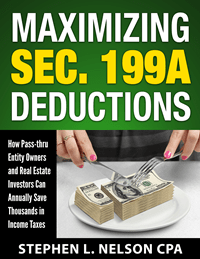As you work on preparing your 2018 income tax return, you may wonder how much income tax the new Section 199A deduction saves you.
This post, accordingly, explains how most small businesses and rental property owners calculate the Section 199A deduction and its tax savings.
Note: The information that appears here has been updated for the Section 199A final regulations which appeared on January 18, 2019.
Step 1: Estimate Qualified Business Income
Your first step? Estimate the qualified business income you potentially get to plug into the formula.
Qualified business income includes the profits shown on a Schedule C (“Profit or Loss from Business”), Schedule E (“Supplemental Income and Loss”) and Schedule F (“Profit or Loss from Farming”). Qualified business income also includes the profits shown in boxes 1, 2 and 3 of a K-1 from a partnership or S corporation and shown in boxes 6, 7 and 8 of the K-1 from a trust or estate. Accordingly, you want to add all this stuff up.
You will probably need to reduce your total “qualified business income” by the “business-y” deductions that don’t appear on the business tax returns calculating the income but which are connected to the business. These deductions include items such as self-employed health insurance, half of your self-employment taxes, and the qualified retirement plan contributions such as a SEP-IRA payment.
Step 2: Estimate Your Taxable Income
You can’t look just at your qualified business income, though. You also need to look at your taxable income net of any capital gains and things taxed like capital gains such as qualified dividend income.
Accordingly, estimate your taxable income and your capital gains and qualified dividends for 2018.
You can make this calculation by adding up all your income and then subtracting these three values:
- Capital gains as reported on Schedule D and qualified dividends reported on Schedule B.
- Other “non-business-y” deductions that you take to calculate your adjusted gross income (including alimony and health savings accounts)
- Either the new standard deduction or the total of your itemized deductions.
In 2018, standard deductions run $12,000 for a single person, $18,000 for someone filing as a head of household, and $24,000 for a married couple filing a joint return.
And itemized deductions (the other alternative) probably equal the total of mortgage interest, charitable deductions and up to $10,000 of your state and local taxes.
As an example of how this calculation works, assume you earn $114,000 in qualified business income from a sole proprietorship, anticipate $10,000 of capital gains and qualified dividends and plan to take the $24,000 standard deduction for 2018, Further assume you will take no other deductions.
In this case, your taxable income net of your capital gains and qualified dividends equals $100,000.
I calculated this $100,000 amount as $124,000 – $24,000 of standard deduction.
Note that the taxable income “net of capital gains and qualified dividends” approach means you can’t use the Section 199A deduction to save paying taxes on the $10,000 of capital gains and qualified dividends.
Step 3: Calculate the Section 199A Deduction
To calculate the actual Section 199A deduction, multiply the smaller value from Step 1 and Step 2 by 20%.
For example, say your qualified business income equals $100,000 but your taxable income equals $50,000. In this case, your Section 199A deduction equals 20% of the $50,000 of taxable income, or $10,000.
As another example, say your qualified business income equals $100,000 but your taxable income net of capital gains equals $150,000.
In this case, your Section 199A deduction equals 20% of the $100,000 of qualified business income, or $20,000.
Step 4: Multiple the Section 199A Deduction by Marginal Tax Rate
The final step in calculating your Section 199A tax savings? You multiple the Section 199A deduction amount by your marginal tax rate.
The table that follows shows you the 2018 marginal rates for each filing status and income bracket:
| Tax Rate | Single Filers | Head of Household Filers | Married Joint Filers |
| 10% | Up to $9525 | Up to $13,600 | Up to $19,050 |
| 12% | $9526 t0 $38,700 | $13,601 to $51,800 | $19,051 to $77,400 |
| 22% | $38,701 to $82,500 | $51,801 to $82,500 | $77,401 to $165,000 |
| 24% | $82,501 to $157,500 | $82,501 to $157,500 | $165,001 to $315,000 |
| 32% | $157,501 to $200,000 | $157,501 to $200,000 | $315,001 to $400,000 |
| 35% | $200,001 to $500,000 | $200,001 to $500,000 | $400,001 to $600,000 |
| 37% | Above $500,000 | Above $500,000 | Above $600,000 |
But say your marginal rate equals 22%. Further say your Section 199A deduction equals $20,000.
In this case, your Section 199A deduction tax savings equals 22% of $20,000, or $4,400.
Special Rules for Special Situations
Most taxpayers can use the steps above to estimate their 199A deduction. But in a couple of situations, a taxpayer’s 199A formula gets a little more complicated.

First of all, taxpayers in the 32%, 35% and 37% tax brackets need the businesses generating the qualified business income to either show lots of W-2 wages or own lots of depreciable property. Again, most people don’t have to worry about this complication. But if you do? Check out the blog post we published that explains this math: Section 199A Phase-out Calculations.
Second, if you or your spouse earn qualified business income in a specified service trade or business and you’re in the 32%, 35% or 37% tax bracket, you need to know that you may lose the ability to take the Section 199A deduction on your tax return. This area of the new law is complicated. (Basically, the Section 199A statute says that high income professionals can’t use the deduction.)
But don’t give up on the deduction if you’re, say, a doctor or lawyer. Rather, check out our blog post on this element of the new law: Section 199A and the Principal Asset Disqualification.
Other Related Resources
We wrote a blog post specifically for CPAs helping their clients deal with the Section 199A deduction for the CPATrendlines website. If you’re interested that post appears here: 10-Step Sec. 199A Checklist.
If you’re still trying to get a handle on the Section 199A deduction, you might also find this post useful: Pass-thru Income Deduction: 12 things Every Business Must Know
